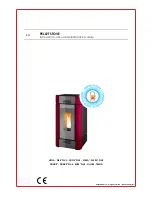
15
Failure to clean and maintain this unit as indicated can result in poor performance and safety hazards.
Unplug your stove’s electrical cord prior to removing the back panel or opening the exhaust system for any inspection, cleaning,
or maintenance work.
Never perform any inspections, cleaning, or maintenance on a hot stove.
Do not operate stove with broken glass, leakage of
fl
ue gas may result.
EXHAUST SYSTEM
Creosote Formation
– When any wood is burned slowly, it produces tar and other organic vapors, which combine with expelled
moisture to form creosote. The creosote vapors condense in the relatively cool chimney
fl
ue or a newly started
fi
re or from a slow-
burning
fi
re. As a result, creosote residue accumulates on the
fl
ue lining. When ignited, this creosote makes an extremely hot
fi
re,
which may damage the chimney or even destroy the house. Despite their high ef
fi
ciency, pellet stoves can accumulate creosote under
certain conditions.
Soot and Fly Ash: Formation and Need for Removal
– The products of combustion will contain small particles of
fl
yash. The
fl
yash will collect in the exhaust venting system and restrict the
fl
ow of the glue gases. Incomplete combustion, such as occurs during
startup, shutdown, or incorrect operation of the room heater will lead to some soot formation which will collect in the exhaust venting
system. The exhaust venting system should be inspected at least once every year to determine if cleaning is necessary.
Inspection and Removal
– The chimney connector and chimney should be inspected by a quali
fi
ed person annually or per ton of
pellets to determine if a creosote or
fl
y ash build-up has occurred. If creosote has accumulated, it should be removed to reduce the
risk of a chimney
fi
re. Inspect the system at the stove connection and at the chimney top. Cooler surfaces tend to build creosote
deposits quicker, so it is important to check the chimney from the top as well as from the bottom. The creosote should be removed
with a brush speci
fi
cally designed for the type of chimney in use. A quali
fi
ed chimney sweep can perform this service. It is also
recommended that before each heating season the entire system be professionally inspected, cleaned and, if necessary, repaired. To
clean the chimney, disconnect the vent from the stove.
Establish a routine for the fuel, wood burner and
fi
ring technique. Check daily for creosote build-up until experience shows
how often you need to clean to be safe. Be aware that the hotter the
fi
re the less creosote is deposited, and weekly cleaning may be
necessary in mild weather even though monthly cleaning may be enough in the coldest months. Contact your local municipal or
provincial
fi
re authority for information on how to handle a chimney
fi
re. Have a clearly understood plan to handle a chimney
fi
re.
INTERIOR CHAMBERS
•
Burn Pot: Periodically clean the burn pot.
•
The burnpot and feed tube elbow will gradually accumulate a buildup of carbon. This will need to be chipped away with
a chipping hammer and blade screw driver. Do not use any other tools for this function, stove damage may result.
•
If a vacuum is used to clean your stove, we suggest using a vacuum designed for ash removal. Some regular vacuum cleaner
(i.e. shop vacs) may leak ash into the room.
DO NOT VACUUM HOT ASH!
ASH DISPOSAL
Disposal of Ashes
-Ashes should be placed in a metal container with a tight
fi
tting lid. The closed container of ashes should be
placed on a noncombustible
fl
oor or on the found, well away from all combustible materials, pending
fi
nal disposal. If the ashes
are disposed of by burial in soil or otherwise locally dispersed, they should be retained in the closed container until all cinders have
been thoroughly cooled.
Remove ashes when unit has cooled. The container shall not be used for other trash or waste disposal. If combined with combustible
substances, ashes and embers may ignite.
CHECK AND CLEAN THE HOPPER
Check the hopper periodically to determine if there is any sawdust (
fi
nes) that is building up in the feed system or pellets that are
sticking to the hopper surface. Clean as needed.
DOOR AND GLASS GASKETS
Inspect the door and glass window gaskets periodically. The door may need to be removed to have frayed, broken, or compacted
gaskets replaced by your authorized dealer.
MAINTENANCE














































